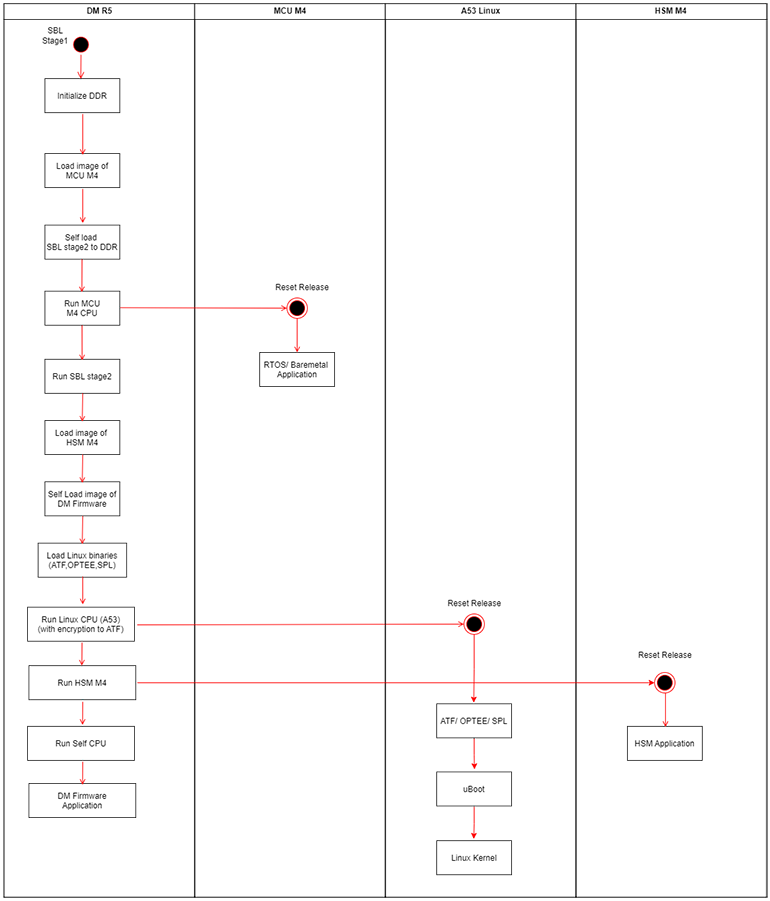Introduction to the TI AM62x Boot Process
The TI AM62x is a high-performance embedded processor widely used in industrial automation, IoT, consumer electronics, and other fields. Its boot process is designed to be highly flexible, supporting multiple boot modes to adapt to various hardware and application scenarios. This article provides a detailed explanation of the AM62x boot process to help developers understand its startup mechanism and provide guidance for project development.
1. Overview of the Boot Process
The Linux boot process of the AM62x begins with the on-chip ROM program, loads the system bootloader, and completes the initialization of the operating system. The entire process is divided into the following phases:

Figure 1 AM62x SBL boot flow chart from eMMC
1.1 DM R5 Stage
Responsible for initializing the basic hardware environment of the processor, such as the DDR controller.
Detects and loads the bootloader from external storage.
1.2 MCU R4 Stage
Handles specific microcontroller functions during the boot sequence, if applicable.
1.3 A53 Linux Stage
Includes Linux binaries, such as ATF, OP-TEE, and the A53 SPL.
Components include:
●tiboot3.bin (equivalent to SBL stage 1, TIFS, and BoardConfig).
●tispl.bin and u-boot.img (SBL stage 2).
●Linux appimage containing the Linux kernel, device tree (DTB), and file system.
2. Required Boot Files in eMMC Partition
To boot the AM62x from eMMC, the following files must be prepared:
2.1 Boot Partition
●tiboot3.bin: Stage 1 bootloader.
●tispl.bin: Stage 2 bootloader (SPL).
●u-boot.img: Main U-Boot image.
●U-Boot environment variables.
2.2 EXT4 Partition in User Data Area
●Linux kernel image.
●Linux device tree blob (DTB).
●Linux file system.
3. Key Considerations in the Boot Process
3.1 Boot Mode Configuration
Ensure that the BOOTMODE pins in the hardware design are configured correctly (high or low) to select the desired boot mode.
3.2 Bootloader and OS Image Programming
Correctly program the SBL and OS images into the eMMC, SD card, QSPI, or NAND flash. Ensure the boot address and partition layout comply with specifications.
3.3 DDR Initialization
In the SBL, configure DDR parameters such as clock and latency to ensure proper memory access.
3.4 Debugging Tools
During development, use TI's Code Composer Studio (CCS) tools and the JTAG debugging interface to quickly identify and resolve boot issues.
4. Conclusion
The TI AM62x boot process is highly flexible and robust, supporting various boot modes and hardware configurations, making it a powerful tool for embedded system development. By understanding the AM62x boot mechanism and its critical phases, developers can streamline system development and debugging, ensuring stability and reliability in their products.
For further technical support or design references, you can contact Hangzhou Weathink Electronics Co., Ltd. As a third-party partner of TI, Weathink offers support in circuit design and recommends the AM62x core board developed by the company.
WTC-AM62XXS SOM: https://www.weathink.com/products/hexinban/11.html






